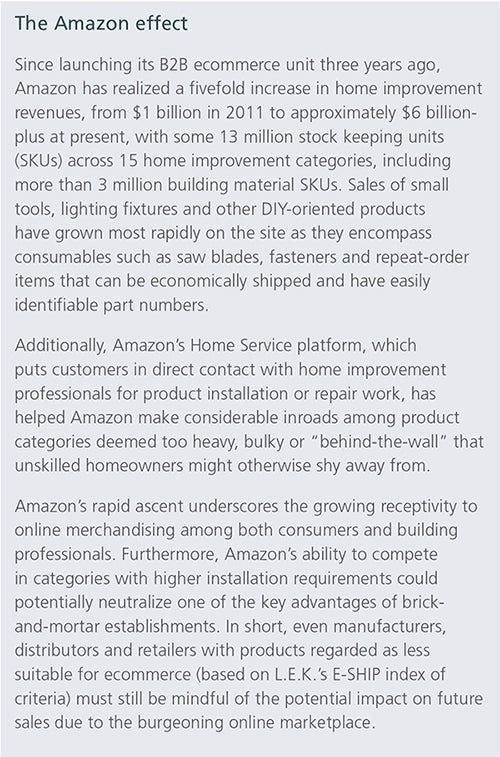
Ecommerce in Home Improvement 2018: Ready or Not
- VOLUME XX, ISSUE 22
- Executive Insights

Ecommerce is poised to disrupt the home improvement industry, thanks to a number of longer-term dynamics.
To evaluate the ecommerce potential of a building product, L.E.K. has developed five criteria that together comprise an index called E-SHIP.
Another way to assess ecommerce potential is to understand the demand moments, or interactions, that homeowners and contractors have with each category.
Both approaches help the industry break down ecommerce opportunities within the status quo. However, incumbent players also must weigh what it would take for the status quo to change.
Disciplined consideration of future scenarios can help companies think through the implications and develop an effective ecommerce strategy to address them.
Ecommerce in the home improvement industry has the potential to disrupt the value chain. Incumbent players — both manufacturers and distributors/retailers — need to capitalize on the opportunity and defend against the risk. To date, ecommerce penetration in building products lags many consumer product categories. Because of this dynamic, ecommerce does not receive nearly the same attention in residential building products as it does in consumer products. It should.
How the dynamics will play out remains to be seen. However, we believe both the disruption and the opportunity are being underestimated in residential building products. We see too many companies looking at the ecommerce channel and offering platitudes about why it isn’t a threat, shouldn’t be a priority, etc. This thinking is dangerous.
In this Executive Insights, we explore the trends around building products ecommerce and discuss the potential implications across the value chain. The purpose of the article is not to be prescriptive with solutions as those will differ by category, role in the value chain, customer type and company capabilities. Rather, our objective is to help create an industry call to action to capitalize on the opportunities and defend against the threats.
L.E.K. has developed a framework — E-SHIP — to identify and evaluate categories that are more likely to go online given the current competition and roles within the value chain (see Figure 1).
To evaluate the ecommerce potential of a building product, we consider five criteria that comprise our E-SHIP index:
Applying the framework to the industry explains why a number of categories have been the first to move online. Plumbing and lighting fixtures, for example, score high on the criteria, while wallboard does not.
The framework helps the industry consider penetration opportunities within the status quo. However, the residential building products industry should be thinking about more than the status quo.
Ecommerce’s ability to penetrate a category depends as much on the category attributes (as mentioned above) as it does on how homeowners and contractors interact with the category. We refer to these interactions as demand moments.
At the simplest level, there are four types of demand moments in residential building products:
Each demand moment has a different opportunity for potential ecommerce penetration. The planned purchase currently has the highest opportunity, whereas the other three types of demand tend to be a poorer fit for ecommerce. When coupled with the E-SHIP assessment, the conclusion could be that much of the building products industry is immune to ecommerce.
Again, we believe this thinking is risky.
What would it take for the status quo to change?
Breaking down the barriers to the ecommerce penetration constraints mentioned above is not difficult to envision.
Take the constraint of job site delivery as an example. Existing building products distributors in many categories perform this service on an hourly basis. Historically, this service has been seen as a barrier to entry for ecommerce. However, are any of the following scenarios difficult to imagine in terms of how ecommerce could become more relevant to companies providing this service in the years ahead?
Are the above disruption scenarios unique to job site delivery? No.

Your company’s ecommerce strategy should be more than a topic that is considered only as part of an annual marketing or channel planning process. It isn’t just a matter of making sure you have your products “online” or are doing things to appropriately merchandise or support MAP pricing. The topic is bigger. This is a C-suite, board-level topic and, as such, you should be provocative and ambitious in your thinking. And given the dynamic nature of ecommerce, the questions to ask can be as important as the answers. We found our most forward-thinking clients are frequently considering and evaluating the following:
These questions require careful attention. We can help. Since 2013, we have handled more than 50 projects in building products in North America in which the topic of ecommerce’s evolution has been central to the assessment. Let us share these experiences and perspectives to help you maximize your digital future.